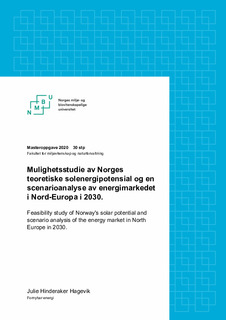| dc.contributor.advisor | Bolkesjø, Torjus Folsland | |
| dc.contributor.advisor | Kirkerud, Jon Gustav | |
| dc.contributor.author | Hagevik, Julie Hinderaker | |
| dc.coverage.spatial | Norway | en_US |
| dc.date.accessioned | 2020-10-07T12:08:43Z | |
| dc.date.available | 2020-10-07T12:08:43Z | |
| dc.date.issued | 2020 | |
| dc.identifier.uri | https://hdl.handle.net/11250/2681580 | |
| dc.description.abstract | Formålet med denne masteroppgaven er å estimere Norges teoretiske solenergipotensial og analysere hvordan denne energien, variert CO2 – kvotepris og ulike investeringer i transmisjonsnettet vil påvirke kraftmarkedet i Nord-Europa i 2030. Beregningene av solenergipotensialet gjøres ved hjelp av solinnstrålingsverktøyet The Photovoltaic Geographical Information System (PVGIS), samt en forutsetning om at det kun kan installeres solceller på tak til allerede eksisterende bygg. Det er benyttet en utnyttelsesgrad på 0,34, som vil si at det er lagt til grunn at 34% av alt grunnareal til bebygd areal er egnet for installasjon av solcellepaneler. Videre er det satt en forventet virkningsgrad på 0,2 for solcellepanelene. Dette gav et totalresultat på 38,8 TWh i årlig potensiell elproduksjon. Det gir Norge et gjennomsnittlig solenergipotensial på 70 kWh/m2/år. Beregningene er utført på fylkesnivå med fylkesgrensene for 2019 som utgangspunkt. Resultatene viser at Akershus er fylket med høyest potensial og Finnmark er fylket med lavest potensial.
I analysen av kraftmarkedet blir den delvis likevekstmodellen Balmorel benyttet til å simulere seks ulike scenarioer over hvordan produksjonen av kraft fra ulike energikilder vil se ut i 2030. I alle simuleringene er den teoretiske norske solenergien blitt implementert som et eksogent sjokk i modellen. Det er benyttet et BASE-scenario for hvordan markedet ville sett ut i 2030 uten solenergipotensialet for å kunne sammenligne. Videre inneholder de seks scenarioene forskjellige CO2 – kvotepriser, henholdsvis 10, 30 og 50 €/tonn CO2 -ekvivalenter, samt med og uten investeringer i transmisjonsnettet utover det planlagte. Resultatene fra analysen viser at i alle scenarioene vil en få en reduksjon i vindkraftproduksjon på mellom 3 og 4 TWh i året. I nesten alle scenarioene ble det også observert en nedgang i lignitt- og kullkraftproduksjon. Naturgassproduksjonen vil øke i scenarioene med en CO2 – kvotepris på 50 €/tonn CO2 – ekv., trolig som følge av nedgangen i lignitt- og kullkraftproduksjonen. I flertallet av scenarioene som tillot investeringer i utbyggelse av transmisjonsnettet ble det observert en oppgang i kraftproduksjon fra fornybare energikilder. | en_US |
| dc.description.abstract | The purpose of this master's thesis is to estimate Norway's theoretical solar potential and analyze how this energy, different carbon prices and various investments in the transmission grid will affect the power market in the Northern Europe in 2030. The solar potential is calculated using the solar radiation tool The Photovoltaic Geographical Information System (PVGIS), with an assumption that solar cells only can be installed on rooftops of already existing buildings. A utilization rate of 0.34 has been used. This means that it is assumed that 34% of all the area covered by buildings in Norway is to be considered suitable for installation of PV. The expected efficiency for the solar panels has been set to 0.2. These calculations have shown that Norway has an annual theoretical solar potential of 38.8 TWh. This gives Norway an average solar potential of 70 kWh/m2/year. The calculations are carried out per county with the county boundaries for 2019. The results show that Akershus is the county with the highest potential and Finnmark is the county with the lowest potential.
In the analysis of the power market, the partial equilibrium model Balmorel is used to simulate seven different scenarios on how the power market would look like in 2030 given the different assumptions taken in this thesis. The assumptions are installation of 38.8 TWh/year Norwegian solar power, carbon prices of 10, 30, and 50 €/tons CO2- equivalent. and with and without exogenous investments in the transmission grid. A BASE-scenario has been used to illustrate how the energy market would be in 2030 without the solar potential integrated. The results of the analysis show that there will be a reduction in wind power production of 3 to 4 TWh per year. In almost all scenarios there was observed a decline in lignite- and coal power generation. Natural gas production will increase in the scenarios with a carbon price of 50 €/tons CO2- eq.. This is probably a result of the decline in the lignite- and coal power generation. There was observed an increased power generation from renewable energy sources in the majority of the scenarios that allowed investments in the development of the transmission grid. | en_US |
| dc.language.iso | nob | en_US |
| dc.publisher | Norwegian University of Life Sciences, Ås | en_US |
| dc.rights | Attribution-NonCommercial-NoDerivatives 4.0 Internasjonal | * |
| dc.rights.uri | http://creativecommons.org/licenses/by-nc-nd/4.0/deed.no | * |
| dc.subject | Fornybar energi | en_US |
| dc.subject | Solenergipotensial | en_US |
| dc.subject | Norge | en_US |
| dc.subject | Energimarked | en_US |
| dc.subject | Energimarkedsanalyse | en_US |
| dc.subject | Mulighetsstudie | en_US |
| dc.subject | Solenergi | en_US |
| dc.subject | Kraftmarked | en_US |
| dc.title | Mulighetsstudie av Norges teoretiske solenergipotensial og en scenarioanalyse av energimarkedet i Nord-Europa i 2030 | en_US |
| dc.title.alternative | Feasibility study of Norway's solar potential and scenario analysis of the energy market in North Europe in 2030 | en_US |
| dc.type | Master thesis | en_US |
| dc.description.version | submittedVersion | en_US |
| dc.description.localcode | M-FORNY | en_US |

